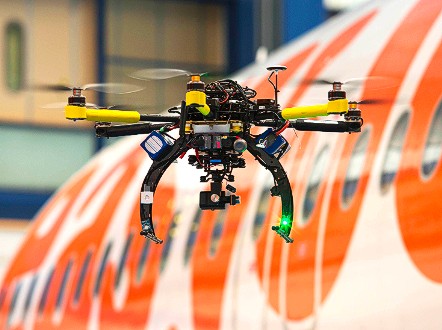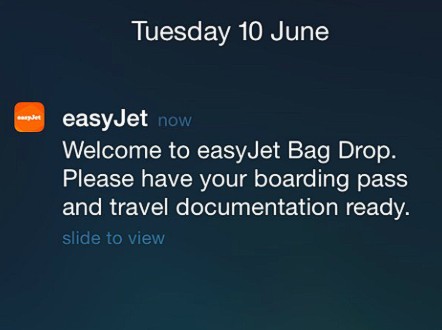Drones, tracking and virtual reality: At an airport near you
updated 11:14 AM EDT, Tue August 19, 2014

Airports are starting to use iBeacon technology to ease overcrowding.
STORY HIGHLIGHTS
- Airports are using phone tracking to give passengers updates on flight status, airport retail deals, more
- EasyJet is also trialing drones for plane inspections
- The carrier is looking at virtual reality to help pilots and engineers
But it's certainly something airport managers are working on.
Still, all the spas, yoga studios and movie cinemas in the world can't detract from the main source of travel anxiety: grueling lines.
It's an irksome feature that may soon become a relic, thanks to the advent of mobile tracking technology.
Helsinki Airport recently
became the first in the world to track passenger movements in real
time, from the parking lot to departure gates.
"The whole idea is to get
better analytics of passenger flow. Really, it's only because we want
to know better where bottlenecks form in the airport during rush hour,"
says Jarno Putta, vice president and chief information officer at
Finavia Corporation, which manages the airport.
EasyJet has started using drones for plane inspections
Courtesy EasyJet
Passengers can meanwhile
get updates about their flight status, bookmark where they parked (so
they can find their car after their return flight) and chart how long it
will take to get through security.
Once inside, when they pass partnered shops, they can get pinged with offers.
While receiving updates
directly to one's phone may seem intrusive, Putta is adamant that the
system doesn't collect any personal information.
Rather, it uses iBeacons
and Wi-Fi routers to collect unique identifier numbers (or MAC
addresses), and only from devices with the Wi-Fi settings turned on.
"The MAC addresses we use are scrambled, which means no one can be traced," he says.
EasyJet makes use of drone inspections
EasyJet is trialing similar technology at London Gatwick, Luton and Paris Charles de Gaulle airports, also using iBeacon.
The carrier is starting small -- placing the devices at baggage drop offs and security areas.
The EasyJet app also uses the technology to alert passengers to ready their documents at key points.
Though still in its early stages, James Millett, EasyJet's head of digital, anticipates it could have father-reaching uses.
"In time, we could see
applications supporting individual challenges, like when a customer
needs to be in a different location because they are carrying skis, or
aren't carrying any hold luggage," he says.
Who wouldn't be creeped out by the idea of having your phone tracked?
Jules Polonetsky, Future of Privacy Forum
The European low-cost carrier has been at the forefront of utilizing the newest technology.
In May, it started trialing inspection by drone on its fleet of Airbus A319 and A320 planes.
The airline is also
looking into the use of virtual reality glasses to allow engineers and
pilots to capture pictures of potential issues, and send them directly
back to base.
"It's another good
example of how we're applying new technologies to our business to help
us be more effective and efficient," says Millett.
Passengers need power to opt out
Not everyone is comfortable with the new technology.
"Who wouldn't be creeped
out by the idea of having your phone tracked? If I tell you someone's
tracking you, and don't tell you why, of course you'd be upset," says
Jules Polonetsky, executive director and co-chair of the
Washington-based think tank Future of Privacy Forum.
He adds that, contrary to how it may seem, airport tracking is kept pretty general.
EasyJet uses real-time tracking to give passengers flight updates
Courtesy EasyJet
"It's not like it
reports, 'hey, this phone belongs to the guy with blue glasses and a
shabby suitcase.' It's '38,000 devices were in this location between
these hours.' It's critical for airports and retailers to demystify this
technology's uses for users."
Transparency is key,
says Polonetsky, and airports need to make sure to alert passengers to
the when, how and why of this technology, and provide them with an
option to opt out -- which both EasyJet and Helsinki Airport do.
Passengers who don't wish to be tracked can either switch off Wi-Fi on their devices, or provide their MAC address to walkbase.com and smart-places.org. (In doing so, the tracking systems knows to ignore the address in the future.)
Mainly, though, he recognizes the many potential uses of this technology at the airport.
"An airport is the type
of place where you probably do want to get pinged about gate changes, or
find out where you can get a cup of coffee once you're checked in, or
information on where the gate is and how much time it will take to get
to it," he says.
"It's a big space, and anything the venue can do to help me navigate it easily and quickly is useful."
From Around the Web
-
7 Caribbean Dive Spots You Can Access Without Scuba Gear Destination Tips
-
Top Ten Cheap All-Inclusive Resorts Trip Curator
-
The 10 Oldest Living Things On Earth brainjet.com
-
7 restaurant gimmicks you shouldn't swallow Bankrate.com
-
Wow! Here Are New Jersey’s Most Popular Shopping Experiences New Jersey Tourism
More from CNN


No comments:
Post a Comment
Please leave a comment-- or suggestions, particularly of topics and places you'd like to see covered